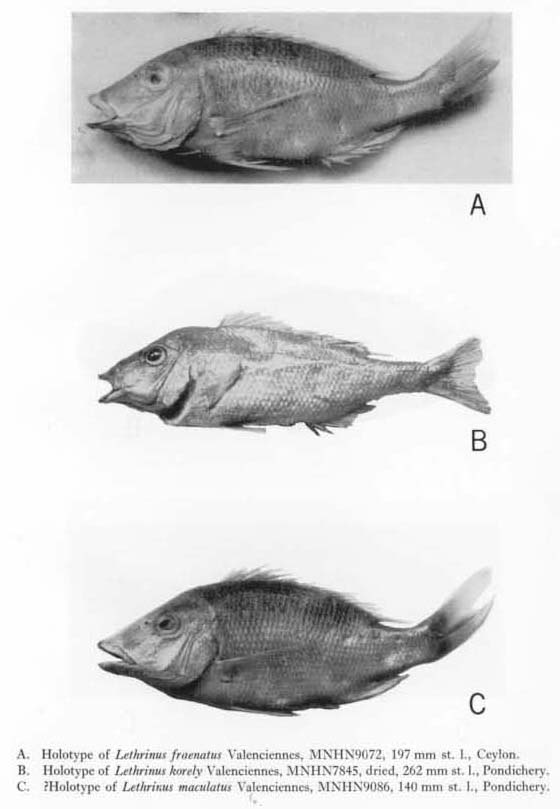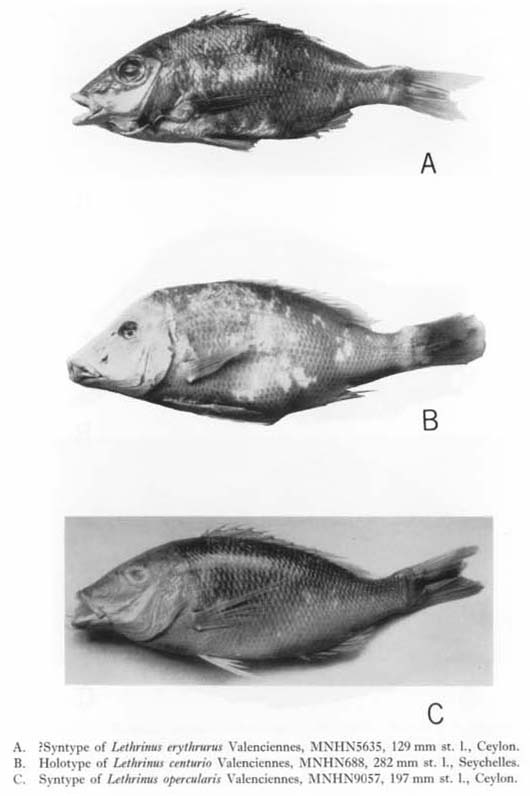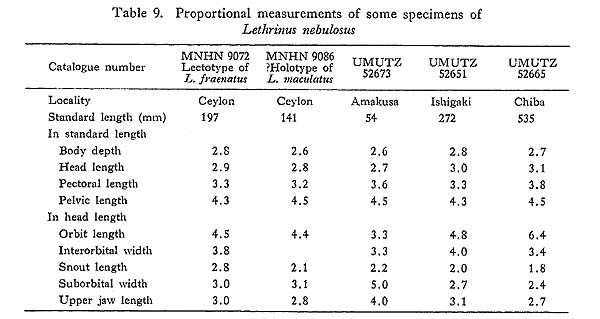V. DESCRIPTIONS
9. Lethrinus nebulosus (Forsskål)
9. Lethrinus nebulosus (Forsskål) |
 Plate 2 |
 Plate 3 |
 Plate 4 |
Sciaena nebulosa Forsskål, 1775: 52, Red Sea; Klausewitz fie Nielsen, 1965: 21, pl. 20, type.
Lethrinus nebulosus; Rüppell, 1840: 118, Red Sea; Barnard, 1927: 633, pl. 25, fig. 3, Delagoa Bay, type of L. scoparius; Blegvad, 1944: 136, fig. 74, Iranian Gulf; Fourmanoir, 1957: 126, fig. 94, Canal de Mozambique; Smith, 1959: 286, 290, pl. 20, East Africa, type; Mahdi, 1971: 25, pl. 10, fig. 49, Kuwait.
Sparus choerorynchus Bloch & Schneider, 1801: 278, Japan.
Lethrinus chaerorhynchus; Valenciennes in Cuvier & Valenciennes, 1830: 308, type.
Lethrinus choerorhynchus; Okada, Uchida, & Matsubara, 1935: 168, pl. 83, fig. 3, Japan; Akazaki, 1962: 246, fig. 43, Wakayama, Okinawa (Japan), Persian Gulf, Bay of Bengal; Shinohara, 1963: 44, Ryukyus; Kyushin et al., 1977: 154, East Burma Sea, Chagos; Masuda et al., 1975: 59, fig. E, 233, southern Japan.
Lethrinus choerorynchus; Sato, 1971: 133, fig. 6, Japan, Pescadores; Gushiken, 1972: 38, fig. 186, Okinawa Is.; Kyushin et al., 1973: 71, Andaman.
Lethrinus Gothofredi Valenciennes in Cuvier & Valenciennes, 1830: 286, Suez.
Lethrinus fasciatus Valenciennes in Cuvier & Valenciennes, 1830: 290, Trincomalee (Ceylon).
Lethrinus fraenatus Valenciennes in Cuvier & Valenciennes, 1830: 291, Ceylon.
Lethrinus korely Valenciennes in Cuvier & Valenciennes, 1830: 292, Pondichery.
Lethrinus maculatus Valenciennes in Cuvier & Valenciennes, 1830: 292, Pondichery.
Lethrinus erythrurus Valenciennes in Cuvier & Valenciennes, 1830: 293, Ceylon.
Lethrinus centurio Valenciennes in Cuvier & Valenciennes, 1830: 301, Seychelles.
Lethrinus alboguttatus Valenciennes in Cuvier & Valenciennes, 1830: 314, Bonin.
Lethrynus esculentus Valenciennes in Cuvier & Valenciennes, 1830: pl. 158.
Lethrinus cyanoxanthus Richardson, 1843: 7, pl. 4, fig. 1, Houtmans Abrolhos (western Australia).
Lethrinus anatarius Richardson, 1844: 145, Canton; Whitehead, 1969: pl. 5, type.
Lethrinus Güntheri Bleeker, 1873b: 153, 1 pl., Nagasaki (Japan).
Lethrinus scoparius Gilchrist & Thompson, 1908-11: 168, Natal.
Lethrinus carinatus Weber, 1913: 289, fig. 68, pl. 2, fig. 1, New Guinea.
Lethrinus fletus Whitley, 1943: 138, Queensland; Marshall, 1964: 201, pl. 26, fig. 213, Queensland.
Lethrinus haematopferus (not of Temminck & Schlegel); Boeseman, 1947: 77, Japan (part).
Specimens examined.
Holotype. —ZMK-P49345 (D, 190 mm standard length) from Red Sea.Holotype of Sparus choerorynchus. —ZMHU 8743 (D, 174) from Japan.
Holotype of Lethrinus fasciatus. —MNHN9081 (165) from Trincomalee, Ceylon.
Holotype of L. fraenatus. —ZMNV[N9072 (1 of 2 individuals: 197) from Ceylon.
Holotype of L. korely. —MNHN7845 (D, 262) from Pondichery, India.
?Holotype of L. maculatus. —MNHN9086 (140) from Pondichery.
?Sytype of L. erythrurus. —MNHN5635 (2: 129, 141) from Ceylon.
Syntypes of L. centurio. —MNHN688 (2: 252, 282) from Seychelles.
Holotype of L. Güntheri. —RMNH5766 (93) from Japan.
ZMHU9847 (200), 7985 (200), SMF2774 (D, 222), 2777 (D, 300) from Red Sea.
SMF10896 (172) from Farasan I., Red Sea.
ZMK4958 (150) from Mombasa.
MNHN9081 (165) from Trincomalee, Ceylon.
SMF5617 (120) from Bay of Bombay, India.
UMUTZ16412 (230) from Phuket.
UMUTZ14592 (80) from Philippines.
BMNH1851. 12. 27. 45 (1 of 2: 88) from China.
UMUTZ52678 (125), 52681 (130), 52452 (155), 52451 (158), 52450 (167), 52448 (200) from Pescadores, Formosa.
RMNH2181 (445), UMUTZ52624 (43), 52673 (54), 18571 (80), 8094 (86), 3762 (93), 24713 (93), 3734 (100), 52481 (104), 52480 (125), 9664 (145), 18625 (145), 52532 (170), 23770 (175), 23771 (190), 52621 (193), 25620 (207), 52481 (104), 52480 (125), 52636 (210), 8564 (213), 52529 (220), 52507 (240), 12352 (242), 52531 (250), 52650 (253), 52530 (270), 52651 (272), 52665 (535), 52666 (625), ABE4023 (205), TUFO 707 (415), 155 (428), 137 (457), 156 (575) from Japan.
BMNH90. 9. 23. 203 (400) from Pt. Jackson.
D. X, 9; A. III, 8; P1. 13; P2. I, 5; C. 8 + 7; L. lat. 45 to 48; Ltr. 6 or 7/i/15 to 17.
Proportional measurements of some specimens are shown in Table 9.

Head length less than body depth in adults at least. End of jaws usually on the vertical through anterior nostril. Interorbital area convex. Third to fifth dorsal spines longest. 6 scale rows between lateral line and median dorsal spines. Inner base of pectoral densely covered with scales. Lateral teeth of jaws include rather small but distinct molars in adults.
Color. —Olive-green above, paler below. Usually two or three blue streaks radiating from eye. Individual scales on the back with white center. Sometimes several yellow longitudinal stripes on side. A white spot on posttemporal conspicuous in life. Fins yellow, mottled or striped with orage to red. Upper margin of pectoral blue.
One of the commonest species, attaining 60 cm.
Distribution. —Red Sea, East Africa to central Japan.
Remarks. —The large number of synonyms seems to be due to the fact that this species is widely distributed and shows fair variation in body shape. However, it is at the same time one of the easiest species to identify because of its characteristic color pattern.
The type of Sciaena nebulosa is a dried half-skin. Though it is rather difficult to examine such specimens sufficiently, this specimen seems to belong to the present species.Furthermore, Forsskål's description of S. nebulosa agrees well with the characteristic color pattern of the present species. There has been some discussion on the reliability of the above specimen as the type (Klausewitz & Nielsen, 1965: 21).
Though the type of L. Gothofredi has not been found, this species seems to be identical with the present species from the original description.
The specimen MNHN9081 (165 mm standard length) lacks any indication of the type of L. fasciatus but agrees with the original description of that species fairly well and seems to be the type.
Valenciennes's description of L. fraenatus was based on a single specimen, but two individuals indicated as the types of L. fraenatus (MNHN9072) are kept in the Museum National d'Histoire Naturelle in Paris. They belong to different species from each other. The larger (197mm standard length) agrees with the original description better and must be the holotype.
The specimen MNHN9086 (140 mm standard length) of the same Museum is labeled as " L. fasciatus (maculatus) C. V. Pondichery. Leschenault" without any indication of the type. But the present author provisionally regards the specimen as the type of L. macidatus because all characteristics agree exactly with the original description.
In the same Museum the author found two specimens of Reynaud's from Ceylon labeled L. erythrurus (MNHN5635: 129 and 141 mm standard length). Though they are not accompanied by any indication of types, they are probably among the syntypic series.
L. alboguttatus was based on a drawing of Mertens & Ketlitz, which was in turn based on a fish from the Bonin Is. where the present species is abundant.
L. cyanoxanthus was also based on one of Lieut. Emery's rather crude drawings, but this drawing shows clearly the characteristic color pattern of the present species.
L. anatarius was again based on a drawing of Reeve's which was republished by Whitehead (1969). It also shows the characteristic color pattern of the present species very well.
